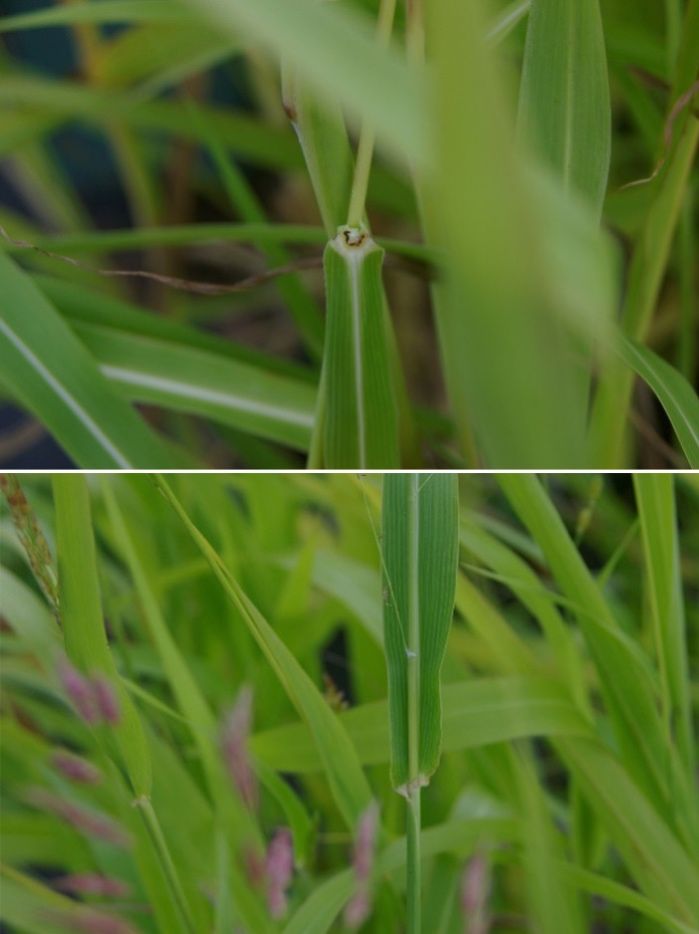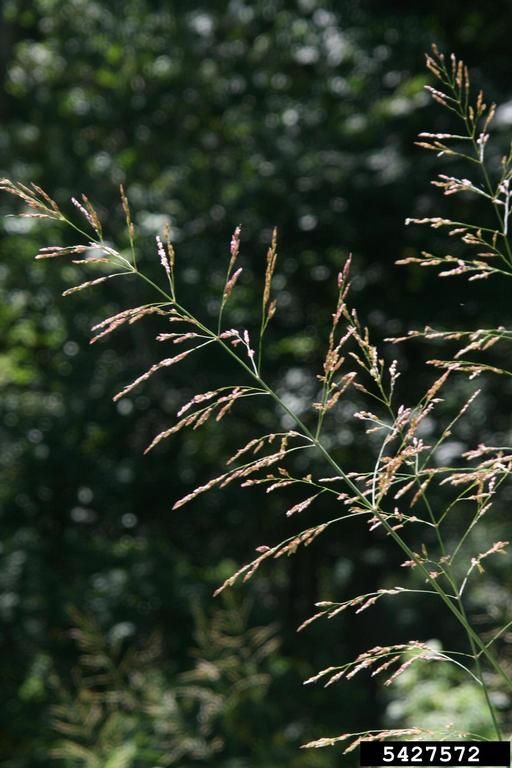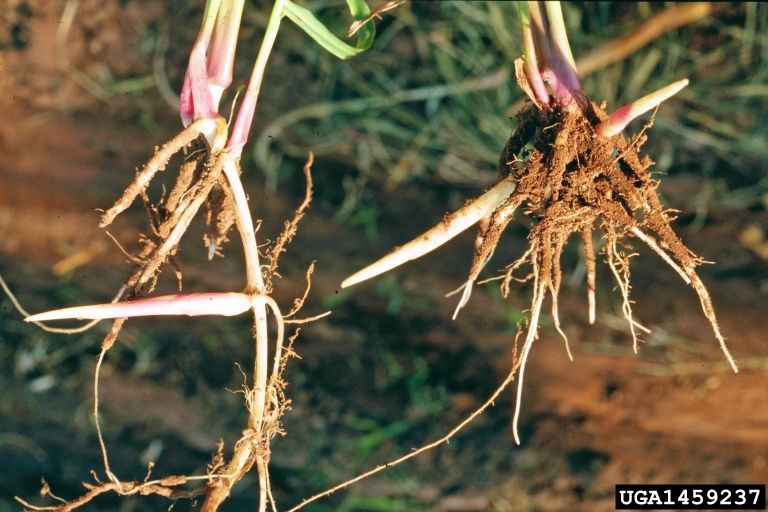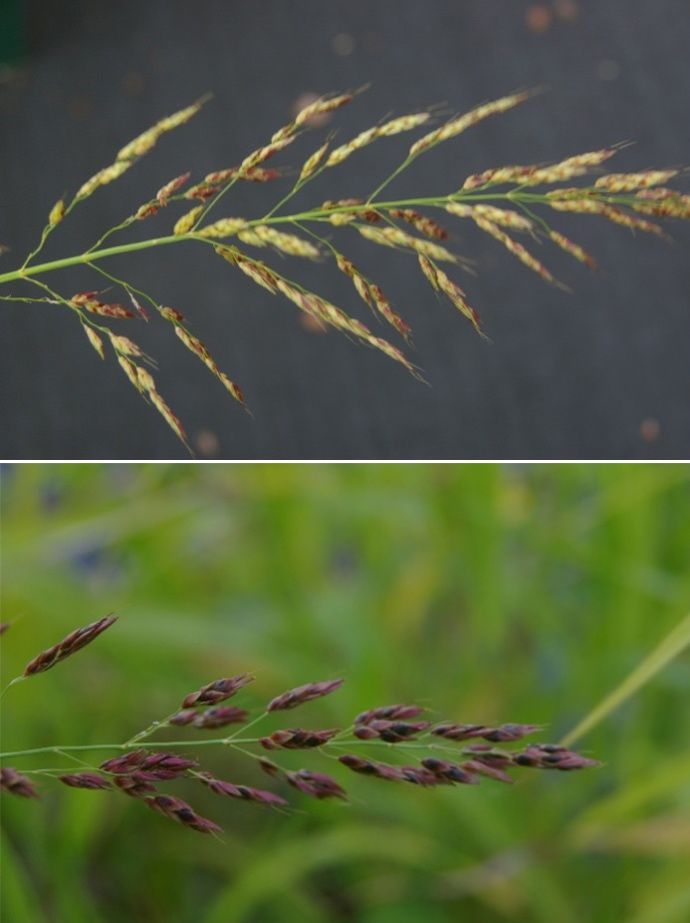Introduction
Johnsongrass [Sorghum halepense (L.) Pers.] is a warm-season perennial grass and one of the most persistent and troublesome weeds in the southern United States (Mueller et al. 1993). This EDIS publication was developed to help commercial nursery growers, landscapers, and other green industry professionals identify and manage johnsongrass.
Species Description
Class: Monocotyledonous plant
Family: Poaceae (Gramineae)
Other Common Names: barool, Aleppo bartgras, Aleppo grass
Life Span: Perennial grass
Habitat: Johnsongrass is often found growing in nutrient-rich soil but can survive in any type of soil, though it is not tolerant to flooding (McWhorter 1972). It is often found in arable lands, meadows, waste places, roadsides, and field borders, and along irrigated canals and edges of irrigated fields. It is an occasional weed in nursery containers but primarily problematic in noncrop areas such as walkways, aisles, and other disturbed sites. In landscapes, it can be found in planting beds in and around ornamental plants.
Distribution: Sorghum halepense is native to wet subtropical habitats from the Mediterranean region and has been introduced and naturalized throughout much of the United States and the world. In the United States, Sorghum halepense can be found in Alabama, Florida, Georgia, Kentucky, Mississippi, North Carolina, South Carolina, Tennessee, and Texas (Dowler 1993). Globally, Sorghum halepense is distributed in Argentina, Australia, Brazil, Chile, Colombia, Cuba, India, Indonesia, Iran, Italy, Mexico, Netherlands, New Zealand, Pakistan, Peru, South Africa, Spain, the United States, and many other tropical to subtropical areas (Holm et al. 1991).
Growth Habit: Johnsongrass grows in spreading patches due to its creeping rhizome system. It grows upright with a mature height that can range from 3 to 8 ft.
Seedling: The emerging sheath (coleoptile) of johnsongrass is maroon in color and grows to ½ inch long. Johnsongrass ligules are membranous, measure 3/16 inch long, and have ragged, hairy upper edges (Figure 1).

Credit: Bruce Ackley, The Ohio State University, Bugwood.org
Shoot: Stout, unbranched stems up to 3 to 8 ft. in height with leaf blades up to 1.5 in. wide (Figure 2).

Credit: Annette Chandler, UF/IFAS
Leaves: Leaves are typically 8 to 24 inches long but can be as long as 35 inches. Leaves have a prominent white midrib and rough underside. The leaves are rolled in the bud, do not have auricles, and have a membranous ligule with shallow teeth across the top (Figure 3).

Credit: Annette Chandler, UF/IFAS
Inflorescence: Large, loosely branched, purplish, pyramidal hairy panicles containing red-purple flowers (Figure 4).

Credit: Chris Evans, University of Illinois, Bugwood.org
Roots: Johnsongrass has a thick and aggressively growing/creeping rhizome system. When it is mature, fleshy white rhizomes can be seen if plants are hand-pulled (Figure 5).

Credit: Steve Dewey, Utah State University, Bugwood.org
Fruit and Seeds: The johnsongrass seed head has an open angular panicle, is reddish-brown or red/black, and ranges from 4 to 20 inches long (Figure 6). Seeds are produced annually, typically in the fall, and can remain dormant for long periods of time.

Credit: Annette Chandler, UF/IFAS
Similar Species: Vaseygrass (Paspalum urvillei) and guinea grass (Megathyrsus maximus) are two similar species that are often confused for johnsongrass. All three grasses have a noticeable white midrib and are large troublesome grasses. Vaseygrass stems have hairs where the leaf meets the stem or on the bottom of the stem, whereas johnsongrass stems have no hairs. Vaseygrass seed heads are also spikelets, whereas johnsongrass has an open-panicle seed head. For johnsongrass and guinea grass, color and size of the seed heads are two of the more obvious differences. Johnsongrass seeds are much larger and have a red/black mottled color, while guinea grass seeds are smaller and somewhat green. A complete guide to identification of these three species is available in the EDIS publication Identification and Control of Johnsgrass, Vaseygrass, and Guinea Grass in Pastures.
Plant Biology
Johnsongrass thrives in moist environments, but it can also persist in drier areas due to its extensive rhizome system. The seeds of johnsongrass can emerge from the top 3 inches of soil (Holm et al. 1991). Johnsongrass can grow from both seeds and overwintering rhizomes, both growing rapidly as temperatures rise (Warwick et al. 1984). However, seedlings from rhizomes grow faster than those from seeds. Seeds germinate at a temperature range of 70°F to 75°F within a year and remain viable for up to 6 years. Rhizome sprouting occurs in the early spring at an average temperature above 60°F. A single johnsongrass plant can produce 200 to 300 feet of new rhizome growth per year. Aboveground structures and older rhizomes die off in winter, but new rhizome growth persists and forms new sprouts the following spring.
Management
Physical and Cultural Control
Johnsongrass is difficult to control in any production setting due to its reproduction through seeds and rhizomes. It is nearly impossible to completely remove johnsongrass rhizomes once established. Therefore, when possible, using integrated control methods (physical, cultural, and chemical) is the recommended approach. Hand-weeding should occur when soil is moist to ensure that all vegetative portions (roots, rhizomes, etc.) are removed. Hand-pulled plants need to be removed from production areas or landscape beds because any seeds left behind can continue to germinate. When hand-weeding, also note that any rhizome pieces left behind can regrow into new plants if not removed and disposed of. Frequent short mowing below johnsongrass growth points can reduce its growth and regrowth and reduce seed production. Preventing johnsongrass from reaching flowering and seed production can minimize its spread through seeds and reduce its seed deposit to the soil seed bank.
Chemical Control
PREEMERGENCE
Johnsongrass growth from seeds can be reduced through timely preemergence herbicide applications. However, containers and fields must be weed-free prior to application because these products generally do not work on emerged plants. While these products do provide control, johnsongrass continues to be a difficult weed to control due to the number of seeds it produces and the fact that if already established, preemergence herbicides will not reduce or suppress growth from rhizomes. Table 1 includes a partial list of preemergence herbicides labeled for controlling johnsongrass from seed. To control johnsongrass seedlings from rhizomes, postemergence herbicides are often needed.
POSTEMERGENCE
Although there are many postemergence herbicides available to control johnsongrass, the selection becomes narrower when managing it in and around ornamental plants. Graminicides, which are herbicides that are selective for grassy weeds, such as fenoxaprop-P (Acclaim), clethodim (Envoy), fluazifop-P-butyl (Fusilade II, Ornamec), and sethoxydim (Segment), can offer control and can be applied over the top of many ornamental plant species. In noncrop areas or situations where directed applications can be made, nonselective herbicides such as glyphosate (many trade names) could be used. Due to its perennial life cycle and ability to spread via rhizomes, contact herbicides such as glufosinate (Finale), pelargonic acid (Scythe) or diquat (Reward) are usually only effective on very small seedlings. Table 2 shows some list of postemergence herbicides that are effective for johnsongrass control. In all cases, postemergence herbicides are most effective when the weeds are small and actively growing. Always consult the manufacturer’s label and follow all precautions when applying herbicides.
The best time to apply postemergence herbicides for johnsongrass control is early spring and late summer. The early spring herbicide applications ensure that active growing seedlings of johnsongrass form enough leaves to absorb sufficient herbicides and translocate to rhizomes. The late summer applications ensure the herbicides are translocated to rhizomes to reduce its regrowth the following spring.
References
Holm, L. G., D. L. Plucknett, J. V. Pancho, and J. P. Herberger. 1991. The World’s Worst Weeds. Distribution and Biology. Krieger Publishing Company.
McWhorter, C. G. 1972. “Flooding for Johnsongrass Control.” Weed Sci. 20 (3): 238–241. https://doi.org/10.1017/S0043174500035499
Mueller, J. P., W. M. Lewis, J. T. Green, and J. C Burns. 1993. “Yield and Quality of Silage Corn as Altered by Johnsongrass Infestation.” Agron. J. 85 (1): 49–52. https://doi.org/10.2134/agronj1993.00021962008500010010x
Sellers, B., H. Smith, and J. Ferrell. 2018. “Identification and Control of Johnsongrass, Vaseygrass, and Guinea Grass in Pastures.” EDIS 2012 (8). https://edis.ifas.ufl.edu/publication/ag372
Smith, C. W., and R. A. Frederiksen (eds.). 2000. Sorghum: Origin, History, Technology, and Production. New York: John Wiley and Sons, Inc.
Warwick, S. I., and L. D. Black. 1983. “The Biology of Canadian Weeds.: 61 Sorghum halepense (L.) Pers.” Can. J. Plant Sci. 63 (4): 997–1014. https://doi.org/10.4141/cjps83-125
Table 1. Preemergence herbicides labeled for use in ornamental plant production and landscapes to control johnsongrass (Sorghum halepense) seedlings. Weed Specialist: Chris Marble PhD, UF/IFAS Mid-Florida REC/Environmental Horticulture. Note: This table lists registered pesticides that should be integrated with other pest management methods. Additional information on integrated pest management methods can be requested from UF/IFAS Extension horticulture or agriculture agents. A list of local UF/IFAS Extension offices is available at https://sfyl.ifas.ufl.edu/find-your-local-office/.
Table 2. Postemergence herbicides labeled for use in ornamental plant production and landscapes to control johnsongrass (Sorghum halepense). Weed Specialist: Chris Marble PhD, UF/IFAS Mid-Florida REC/Environmental Horticulture. Note: This table lists registered pesticides that should be integrated with other pest management methods. Additional information on integrated pest management methods can be requested from UF/IFAS Extension horticulture or agriculture agents. A list of local UF/IFAS Extension offices is available at https://sfyl.ifas.ufl.edu/find-your-local-office/.